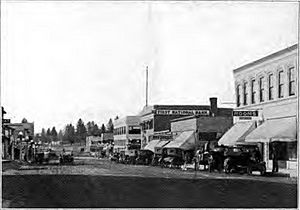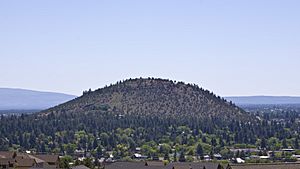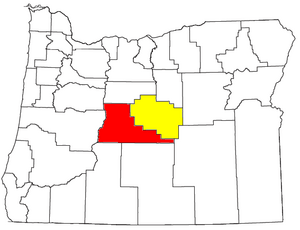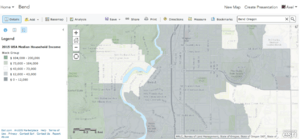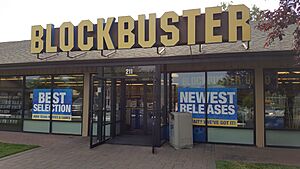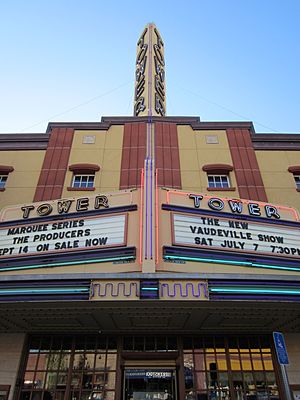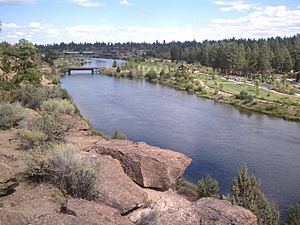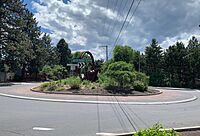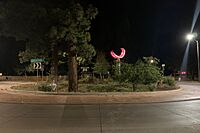Bend, Oregon facts for kids
Quick facts for kids
Bend, Oregon
|
|
|---|---|

Downtown Bend
|
|
| Motto(s):
Bend: Living at Its Best
|
|
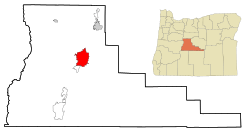
Location in Bend in Deschutes County, Oregon
|
|
| Country | United States |
| State | Oregon |
| County | Deschutes |
| Platted | May 28, 1904 |
| Incorporated | January 4, 1905 |
| Area | |
| • City | 35.046 sq mi (90.769 km2) |
| • Land | 34.801 sq mi (90.135 km2) |
| • Water | 0.245 sq mi (0.635 km2) |
| Elevation | 3,626 ft (1,105 m) |
| Population
(2020)
|
|
| • City | 99,178 |
| • Estimate
(2023)
|
104,557 |
| • Rank | US: 311th OR: 6th |
| • Density | 2,981.0/sq mi (1,151.0/km2) |
| • Urban | 106,988 (US: 305th) |
| • Metro | 260,919 (US: 192nd) |
| Demonym(s) | Bendite |
| Time zone | UTC–8 (Pacific (PST)) |
| • Summer (DST) | UTC–7 (PDT) |
| ZIP Codes |
97701, 97702, 97703, 97707, 97708, 97709
|
| Area code(s) | 541 and 458 |
| FIPS code | 41-05800 |
| GNIS feature ID | 1137914 |
Bend is a city in Central Oregon, USA. It is the main city of Deschutes County. The city is located east of the Cascade Range mountains, right on the Deschutes River.
Long ago, pioneers called this spot "Farewell Bend" because it was a good place to cross the river where it curved. The name was later shortened to "Bend." It became a city in 1905 and started as a town focused on logging (cutting down trees for wood).
In 1910, Mirror Pond was created when a dam was built on the river to make electricity. After 1950, logging slowed down, but Bend grew quickly as a popular place for fun activities and outdoor sports.
Bend is in a high desert area, next to the Deschutes National Forest. It's a popular place for tourists. People come here for breweries, concerts at the Hayden Homes Amphitheater, and even to visit the very last Blockbuster video store.
Outdoor sports are a big deal in Bend. You can enjoy mountain biking, fishing, hiking, camping, rock climbing, white-water rafting, skiing, paragliding, and golf.
Bend is the biggest city in Central Oregon. In 2020, about 99,178 people lived there. This makes Bend the sixth-largest city in Oregon.
Contents
History of Bend
The name Bend comes from "Farewell Bend." This was the name early pioneers gave to a spot on the Deschutes River. It was one of the few places where people could easily cross the river.
For thousands of years, the Bend area was home to Native Americans. They hunted and fished here. In 1824, a fur trapping group led by Peter Skene Ogden explored the area. Later, Army survey teams came through. Pioneers traveling west also crossed the Deschutes River at Farewell Bend.
The first sawmill in Bend was built in May 1901 by the Pilot Butte Development Company. Another small mill was set up in 1903. A small community grew around these mills. In 1904, the 300 residents voted to make it an official city. On January 4, 1905, the city held its first meeting. A. H. Goodwillie became the first mayor. The U.S. Postal Service later shortened the name from "Farewell Bend" to "Bend."
In 1910, Mirror Pond was formed when a dam was built on the Deschutes River. This dam first provided electricity for the city. Today, it still makes enough electricity for about 200 homes. In 1916, Bend became the main city, or county seat, of the new Deschutes County.
Geography of Bend
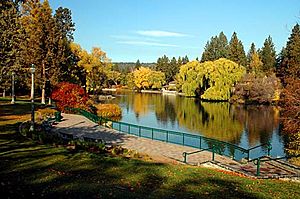
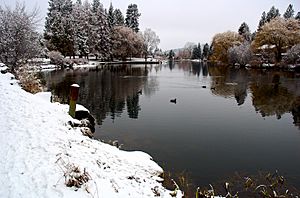
Bend is located where the Eastern Cascades Slopes and Foothills meet the Deschutes River Valley. The Deschutes River flows through Bend and is dammed to create Mirror Pond. Bend is about 3,623 feet (1,105 meters) above sea level.
The city covers about 33.27 square miles (86.17 square kilometers). Most of this is land, with a small amount of water.
Inside Bend's city limits is Pilot Butte State Scenic Viewpoint. This is an old cinder cone, which is a type of small volcano. Bend is one of only three cities in the U.S. that has an extinct volcano within its boundaries. You can reach it by U.S. Route 20.
Just south of Bend, you'll find Newberry National Volcanic Monument on U.S. Route 97.
Climate in Bend
| Weather chart for Bend, Oregon | |||||||||||||||||||||||||||||||||||||||||||||||
|---|---|---|---|---|---|---|---|---|---|---|---|---|---|---|---|---|---|---|---|---|---|---|---|---|---|---|---|---|---|---|---|---|---|---|---|---|---|---|---|---|---|---|---|---|---|---|---|
| J | F | M | A | M | J | J | A | S | O | N | D | ||||||||||||||||||||||||||||||||||||
|
1.5
41
24
|
1.1
44
24
|
0.7
51
28
|
0.7
57
30
|
0.9
65
36
|
0.8
72
42
|
0.6
82
48
|
0.5
81
46
|
0.4
74
40
|
0.6
62
33
|
1.4
47
28
|
2.1
39
23
|
||||||||||||||||||||||||||||||||||||
| temperatures in °F precipitation totals in inches source: NOAA |
|||||||||||||||||||||||||||||||||||||||||||||||
|
Metric conversion
|
|||||||||||||||||||||||||||||||||||||||||||||||
Bend has a semi-arid climate, typical of a high desert. This means it has cool nights and sunny days. On average, Bend gets about 11.2 inches (28.4 cm) of rain each year. It also gets about 23.8 inches (60.5 cm) of snow annually.
Winters in Bend are cool, with an average temperature of about 31.1°F (-0.5°C) in December. Summer days are warm, but nights can be quite cool. The average temperature in July is about 64.5°F (18.1°C). Sometimes, even in summer, it can get cold enough for frost. Autumn usually brings warm, dry days and cooler nights.
Bend has a short growing season for plants. Freezing temperatures can happen as late as June and as early as September.
People of Bend (Demographics)
| Historical population | |||
|---|---|---|---|
| Census | Pop. | %± | |
| 1910 | 536 | — | |
| 1920 | 5,415 | 910.3% | |
| 1930 | 8,848 | 63.4% | |
| 1940 | 10,021 | 13.3% | |
| 1950 | 11,409 | 13.9% | |
| 1960 | 11,936 | 4.6% | |
| 1970 | 13,710 | 14.9% | |
| 1980 | 17,263 | 25.9% | |
| 1990 | 20,469 | 18.6% | |
| 2000 | 52,029 | 154.2% | |
| 2010 | 76,639 | 47.3% | |
| 2020 | 99,178 | 29.4% | |
| 2023 (est.) | 104,557 | 36.4% | |
| U.S. Decennial Census 2020 Census |
|||
Bend is the main city in the Bend-Prineville Combined Statistical Area. This area includes Deschutes County and Crook County. In 2023, about 260,919 people lived in this larger area.
Bend's Population in 2020
In the 2020 census, Bend had 99,178 people living in it. There were about 40,969 households. The city's population density was about 2,950 people per square mile (1,139 per square kilometer).
Most people in Bend (84.5%) identified as White. About 9.2% of the population was Hispanic or Latino. People under 18 made up 20.8% of residents, and 17.0% were 65 or older.
Bend's Population in 2010
In the census of 2010, Bend had 76,639 people. The population density was about 2,322 people per square mile (897 per square kilometer). About 91.3% of residents were White. Hispanic or Latino people made up 8.2% of the population.
About 31.7% of households had children under 18. The average age in the city was 36.6 years.
Economy of Bend
Tourism is a very important part of Bend's economy. The Mount Bachelor ski resort attracts visitors from Oregon, Washington, and California. The nearby Cascade Lakes also bring many tourists. People enjoy skiing, hiking, biking, rafting, golfing, camping, fishing, and rock climbing.
Money collected from a special "room tax" (paid by tourists staying in hotels) helps fund city services like streets, fire, and police. Part of this money also goes to promoting tourism. In 2011, tourism brought in $570 million and provided jobs for 16% of the city's workers. By 2019, the local tourism industry supported 10,000 jobs and brought in over $1 billion.
Bend is home to the Deschutes Brewery, one of the largest craft breweries in the U.S. There are also many other microbreweries in the city. Bend hosts several events celebrating its brewing culture, like the Bend Oktoberfest and Bend Brewfest. You can even visit many breweries along the Bend Ale Trail. As of 2018, Bend had 23 breweries.
In 2019, the Blockbuster Video store in Bend became the very last one left in the world.
Many people also choose Bend as a place to retire. Some tech workers from big cities like San Francisco and Seattle have moved to Bend. They enjoy the outdoor lifestyle and the lower cost of living compared to those larger cities.
Top Employers in Bend
Here are some of the largest employers in Bend:
| # | Employer | What they do | Number of Employees |
|---|---|---|---|
| 1 | St. Charles Health System | Health care | 3,506 |
| 2 | Bend-La Pine School District | Education | 2,300 |
| 3 | Deschutes County | Government | 1,284 |
| 4 | Mount Bachelor | Ski Resort | 1,081 |
| 5 | City of Bend | Government | 717 |
| 6 | United States Forest Service | Government | 615 |
| 7 | Bend Park and Recreation District | Government | 591 |
| 8 | Oregon State University–Cascades | Education | 470 |
| 9 | Lonza Group | Pharmaceutical (medicine) | 463 |
| 10 | Central Oregon Community College | Education | 450 |
Building and Homes
In the early 2000s, many new homes were built in Bend. This was because many people wanted to move there, and it was easy to get loans for houses. This caused home prices to go up a lot.
However, around 2008-2009, the housing market slowed down. Home prices in Bend dropped by more than 40%. This also led to more people being without homes in the area.
Arts and Culture in Bend

Bend is becoming known for its growing art scene. It has many art galleries. The city also hosts the BendFilm Festival, which started in 2004 and shows independent movies.
You can find many public art displays around the city. There's even a "Roundabout Art Route" where you can see outdoor sculptures in the city's traffic circles.
Museums in Bend
- Deschutes Historical Museum (located in the old Reid School building)
- High Desert Museum
Historic Places in Bend
Bend has several buildings and areas listed on the National Register of Historic Places. These include:
- Bend Amateur Athletic Club Gymnasium
- Drake Park Neighborhood Historic District
- Goodwillie–Allen House
- O'Kane Building
- Trinity Episcopal Church
Fun Places to Visit in Bend
- Hayden Homes Amphitheater (for concerts)
- Old Mill District (for shopping and dining)
- Pine Tavern (a historic restaurant)
- Tower Theatre (for shows and movies)
- Old St. Francis School (a former school turned into a hotel with unique features)
- Blockbuster (Bend, Oregon) (the last one!)
Natural Sights in Bend
Sports in Bend
Bend is home to the Bend Elks, a baseball team that plays in the West Coast Collegiate Baseball League. They play at Vince Genna Stadium.
The city also has the Central Oregon Hotshots, a basketball team in the International Basketball League. The Central Oregon Steelheaders play arena soccer.
Bend is a great place for cross-country skiing. The professional team XC Oregon trains and competes here.
Bend has hosted many big sporting events. These include national championships for winter triathlon, trail running, cyclo-cross, and road cycling. In 2019 and 2020, Bend hosted the USA Climbing's National Bouldering Championships.
Cycling is very popular in Bend. The city has over 300 miles (480 km) of mountain bike trails. For many years, Bend was home to the Cascade Cycling Classic, a long-running road bicycle race.
Bend is also home to the Deschutes County Rocks Boxing Team, a program for young boxers.
Parks and Recreation in Bend
The Bend Park & Recreation District takes care of the city's parks, natural areas, and trails.
- Cascade Lakes Scenic Byway
- Deschutes River
- Drake Park
- Pilot Butte State Park
- Shevlin Park
- McKay Park
- Farewell Bend Park
- Riverbend Park
- Ponderosa Skatepark
Education in Bend
Colleges and Universities
Central Oregon Community College offers two-year programs. Oregon State University has its OSU-Cascades Campus in Bend, offering four-year degrees.
Public Schools
The Bend–La Pine School District serves the Bend area. It has five high schools: Bend, Marshall, Mountain View, La Pine, Caldera, and Summit. There are also six middle schools and 19 elementary schools. Some of these are special "magnet schools" with unique programs.
Other special schools include Realms, which focuses on the environment. There are also charter schools like Desert Sky Montessori and Bend International School.
Private Schools
Private schools in Bend include Eastmont School, Cascades Academy of Central Oregon, Seven Peaks, Waldorf School of Bend, St. Francis of Assisi, Morning Star Christian, and Trinity Lutheran School.
Media in Bend
- Newspapers
- Bend Bulletin
- The Source Weekly
- Television
- KTVZ 21 (NBC) - The first TV station in the area.
- KFXO-CD 39 (FOX)
- KOHD 51 (ABC)
- KBNZ-LD 7 (CBS)
- NTVZ-CW (CW)
- KQRE-TM (Telemundo) - Spanish language TV.
- COTV 11 - Shows local events and sports.
- Radio
Bend has many radio stations, broadcasting different types of music and news. Some examples include:
- KBND 1110 AM - News Talk
- KRCO-FM 95.7 FM - Classic Country
- KTWS 98.3 FM - Classic Rock
- KWPK-FM 104.1 FM - Hot Adult Contemporary
Transportation in Bend
Air Travel
The closest airport for commercial flights is Roberts Field (RDM) in Redmond, about 18 miles (29 km) north of Bend. You can fly directly to cities like Seattle, Salt Lake City, and Los Angeles from here. The U.S. Forest Service also has an air base in Bend for fighting wildfires.
Bend Municipal Airport (KBDN) is a smaller airport for private planes.
Bus Services
The Bend Hawthorne Transit Center is a main spot for buses. It connects to regional bus services like Pacific Crest Bus Lines and POINT.
Bend started its own public bus service, B.A.T. (Bend Area Transit), in 2006. Now, Cascades East Transit offers nine bus routes in Bend. The city has also tried out a shared-ride van service.
Roads and Highways
Bend is located where U.S. Route 20 and U.S. Route 97 meet. U.S. Route 97 runs through the city as the Bend Parkway. The city also has the Century Drive Highway, which leads to Mount Bachelor.
To make roads safer, especially for people not driving cars, Bend has been adding many roundabouts (circular intersections).
Train Travel
A BNSF train line runs through Bend. This line is mainly for cargo trains. The closest Amtrak passenger train station is in Chemult, about 65 miles (105 km) south. You can catch the Coast Starlight train there, which travels between Seattle and Los Angeles.
Sustainable Transportation
In 2016, Bend created a 20-year plan to improve its transportation system. The goal is to make the city healthier and fairer for everyone. They are looking at how people move around the city and how land is used.
In 2019, Oregon State University Cascades started a program called Ride Bend. This program used electric vans that you could call with an app, like a shared taxi. The idea was to see if people would prefer shared rides over regular bus routes.
Ride Bend found that more people started using public transportation again. This helped reduce traffic and pollution. The city is working towards a future with better transportation and less waste.
Famous People from Bend
- Ashton Eaton – an Olympic athlete who competes in the decathlon
- Donald M. Kerr – a conservationist who started the High Desert Museum
- Brian Malarkey – a famous chef
- Robert D. Maxwell – a Medal of Honor winner
- Chino Moreno – the lead singer of the band Deftones
- George P. Putnam – a publisher and former mayor of Bend, who was married to Amelia Earhart
- Laurenne Ross – an Olympic skier
- Les Schwab – the person who started Les Schwab Tire Centers
- Derek Sitter – an actor and filmmaker
- Max McNown – a singer and songwriter
Sister Cities
Bend has several sister cities around the world:
 Fujioka Town (now part of Toyota City), Japan
Fujioka Town (now part of Toyota City), Japan Condega, Nicaragua
Condega, Nicaragua Muzaffarabad, Pakistan
Muzaffarabad, Pakistan Belluno, Italy
Belluno, Italy
Images for kids
See also
 In Spanish: Bend (Oregón) para niños
In Spanish: Bend (Oregón) para niños


